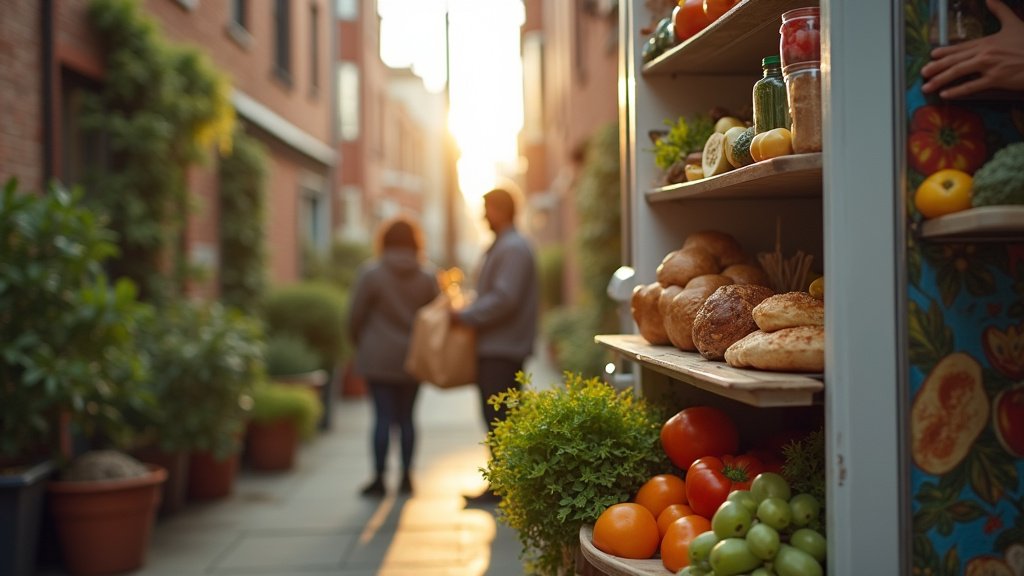Byline: Your Name
In an era marked by evolving economic landscapes and a growing awareness of environmental impact, neighborhood sharing initiatives are not just a quaint throwback but a burgeoning movement answering critical needs. From providing essential food resources to offering sustainable fashion alternatives, these grassroots efforts are weaving stronger community fabrics across the nation. Recent news highlights a surge in popularity for concepts like community fridges and clothing swaps, showcasing a collective desire for resourcefulness, connection, and resilience.
Neighbors Nourishing Neighbors: The Rise of Community Fridges
At the heart of many communities, refrigerators placed in public spaces are quietly revolutionizing how neighbors support each other. These “community fridges” operate on a simple, yet profound, mutual aid principle: anyone can take what they need and leave what they can. Unlike traditional food pantries, they offer anonymous, 24/7 access without limits or stigma, making them invaluable resources for combating food insecurity.
These refrigerators are more than just dispensers of food; they are vibrant hubs for community connection. Stocked by individuals, local businesses, and food rescue organizations, they tackle two pressing issues simultaneously: reducing food waste and ensuring equitable access to fresh produce, non-perishables, and even household items. While they may not solve the systemic causes of hunger, community fridges provide immediate, tangible relief and foster a tangible sense of shared humanity, transforming public spaces into places of care.
Swapping for Style and Sustainability: A Fashion Revolution
In parallel, the world of fashion is witnessing a significant shift, driven by a growing consciousness about its environmental and social footprint. Fast fashion’s model of rapid production and consumption has led to mountains of textile waste and significant resource depletion. In response, clothing swaps are emerging as a powerful and popular alternative.
These events, where individuals exchange gently used clothing, shoes, and accessories, offer a budget-friendly way to refresh wardrobes while championing sustainability. The environmental benefits are substantial: extending garment lifespans reduces the demand for new production, conserves resources, and diverts textiles from landfills. Beyond the economic and environmental advantages, clothing swaps are inherently community-building activities. They foster conversations about ethical fashion, connect like-minded individuals, and often create a festive, party-like atmosphere, as seen in events like Portland, Oregon’s “The Biggest Swap in the Northwest”. This movement taps into a broader trend of conscious consumerism, where individuals actively seek ways to align their fashion choices with their values.
Beyond Food and Fashion: A Network of Shared Resources
The spirit of neighborhood sharing extends beyond clothing and food. “Real sharing economies” are flourishing, offering access to resources that individuals might not otherwise be able to afford or maintain. Tool libraries, for instance, provide community members with access to a wide array of tools for home repairs, gardening, and DIY projects, promoting self-sufficiency and reducing waste. These initiatives, alongside book exchanges, toy libraries, and skill-sharing networks, underscore a collective move towards collaborative consumption and away from purely individualistic ownership.
The broader sharing economy, facilitated by digital platforms, is experiencing robust growth, driven by factors like urbanization, economic pressures, and a generational preference for access over ownership. While large tech companies dominate much of the discourse, community-focused sharing models are proving vital for fostering local resilience and connection.
Building Stronger Communities Through Sharing
These diverse neighborhood sharing initiatives represent more than just convenient ways to acquire goods or services. They are powerful mechanisms for building social capital, fostering trust, and strengthening community bonds. In a world where economic disparities and environmental challenges persist, these grassroots efforts demonstrate the profound impact of collective action and mutual support. As these sharing models continue to evolve and gain traction, they offer a hopeful glimpse into a more connected, sustainable, and resourceful future for our neighborhoods. The ongoing news surrounding these movements underscores their growing importance and lasting appeal.




